American Motorcyclist July 2018
From Honky-Tonk To MX
How Loretta Lynn’s Ranch Became Motocross’ Sacred Ground
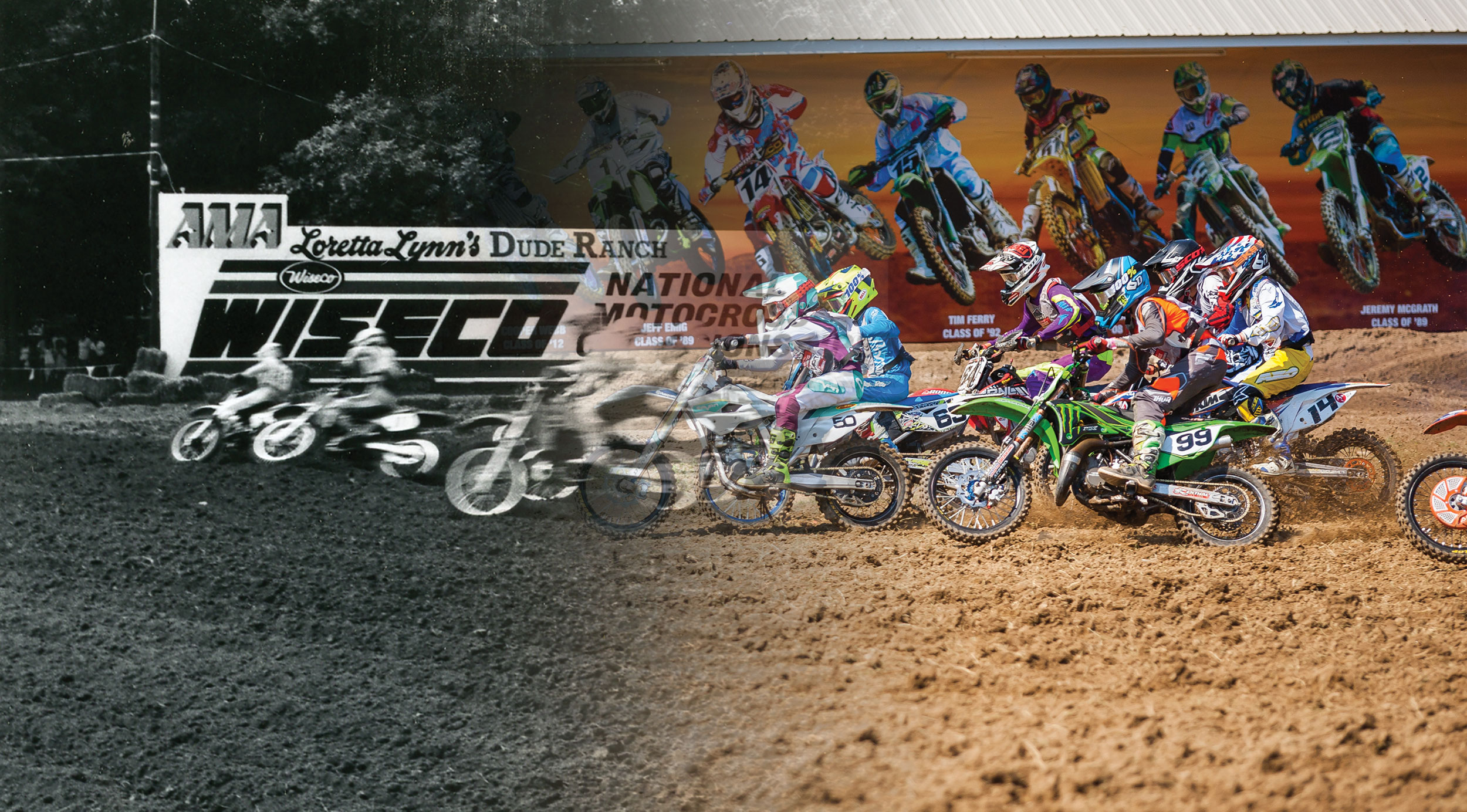
Photos Courtesy Of Racer X Illustrated
By Michael Marino
Many American sports have places that their fans and competitors consider special. In golf, the Augusta National Golf Club has been home to The Masters Tournament since 1934.
In tennis, a place like United States Tennis Association’s Billie Jean King National Tennis Center has been the long-time home of the U.S. Open. In auto racing, places like Daytona International Speedway and Indianapolis Motor Speedway hold a special place in the hearts of many fans and drivers.
For amateur motocross in the United States, the most significant place unquestionably is a country music singer’s dude ranch in the hills of Tennessee.
Loretta Lynn’s Ranch in Hurricane Mills, Tenn., has played home to the Rocky Mountain ATV/MC AMA Amateur National Motocross Championship since 1982. The location is often called “Loretta Lynn’s” or, simply, “Loretta’s.” The 37th edition of the event is set to take place July 30 to Aug. 4, 2018.
For racers, qualifying for the event is difficult and highly competitive. Riders must first contest at AMA-sanctioned area and regional qualifying events, with only the top four to six riders in each class advancing. In 2018, about 24,000 riders entered area qualifiers, competing for about 1,470 starting gate spots in 35 AMA National Championship classes.
To AMA Motocross Manager Ricky Rickords, qualifying to compete at Loretta Lynn’s is a feat in itself.
“As the location of the AMA Amateur National Motocross Championship, Loretta Lynn’s has had a Who’s Who of professional motocross and AMA Supercross racers come through its ranks,” he said. “For those who qualify to compete at it, going to Loretta Lynn’s is like a pilgrimage. It takes so much effort going through the qualifiers just to make it there. By the time a rider gets to Loretta’s, they’ve raced against the top amateur motocross talent in the country.”
Before Loretta’s
In the years before the first Loretta Lynn’s event, amateur motocross lacked a singular national championship event. According to AMA Charter Life Member Paul Schlegel, a co-founder of the Loretta Lynn’s event, there were two competing national amateur motocross events.
A heavily sponsored event was held annually at a track in Ponca City, Okla.
“It was owned by two promoters of AMA motocross events on the West Coast,” Schlegel said. “It was well-sponsored by the industry.”

Loretta Lynn in 1982
The AMA held its own amateur motocross national championship events at different tracks each year.
Davey Coombs, an AMA Life Member and the son of Loretta Lynn’s co-founder, AMA Motorcycle Hall of Famer Dave Coombs, recalled the disparity between the Ponca City and AMA events.
“The [National Motorsport Association] Grand National Championships in Ponca City were much bigger than the two AMA events each year, and it was always in the same place,” he said. “Back then, the AMA had two amateur national events. Amateur was four classes, and Youth was multiple classes for kids 16 and under.
“The AMA’s nomadic national just never realty caught on…because it was never on an even playing field,” Coombs explained. “Wherever it went, locals had a distinct advantage, and they used it. Dad wanted an even playing field, and so did the AMA. The idea of putting it in a place that only had one race a year was the perfect way for us to promote it and for the AMA to officiate it.
Coombs said the idea for a national amateur motocross championship was a product of a family road trip home from Ponca City.
“On our way home from that event my parents pretty much came up with the idea of a similar event, in the middle of the country, at a neutral site, combining all AMA classes,” he said.
When major sponsors began to consider dropping their sponsorship of the AMA event to focus on Ponca City, Dave Coombs and Schlegel decided to act.
The two already were AMA-chartered competition event promoters.
“My parents were AMA race promoters, beginning in 1972. In ’77 and in ’80 my dad promoted the AMA Youth Amateur Nationals at different tracks in Pennsylvania,” Coombs said.
Schlegel promoted the Pontiac, Mich., Silverdome AMA Supercross event.
According to Schlegel, the two men decided they wanted to hold the event as grand as the Ponca City event—or grander. They decided the event needed to be held at a central location in the continental United States to attract competitors from across the country. They also decided the event could not be held at an established motocross track.
“We didn’t want some local rider going out there and beating everyone,” Schlegel said.
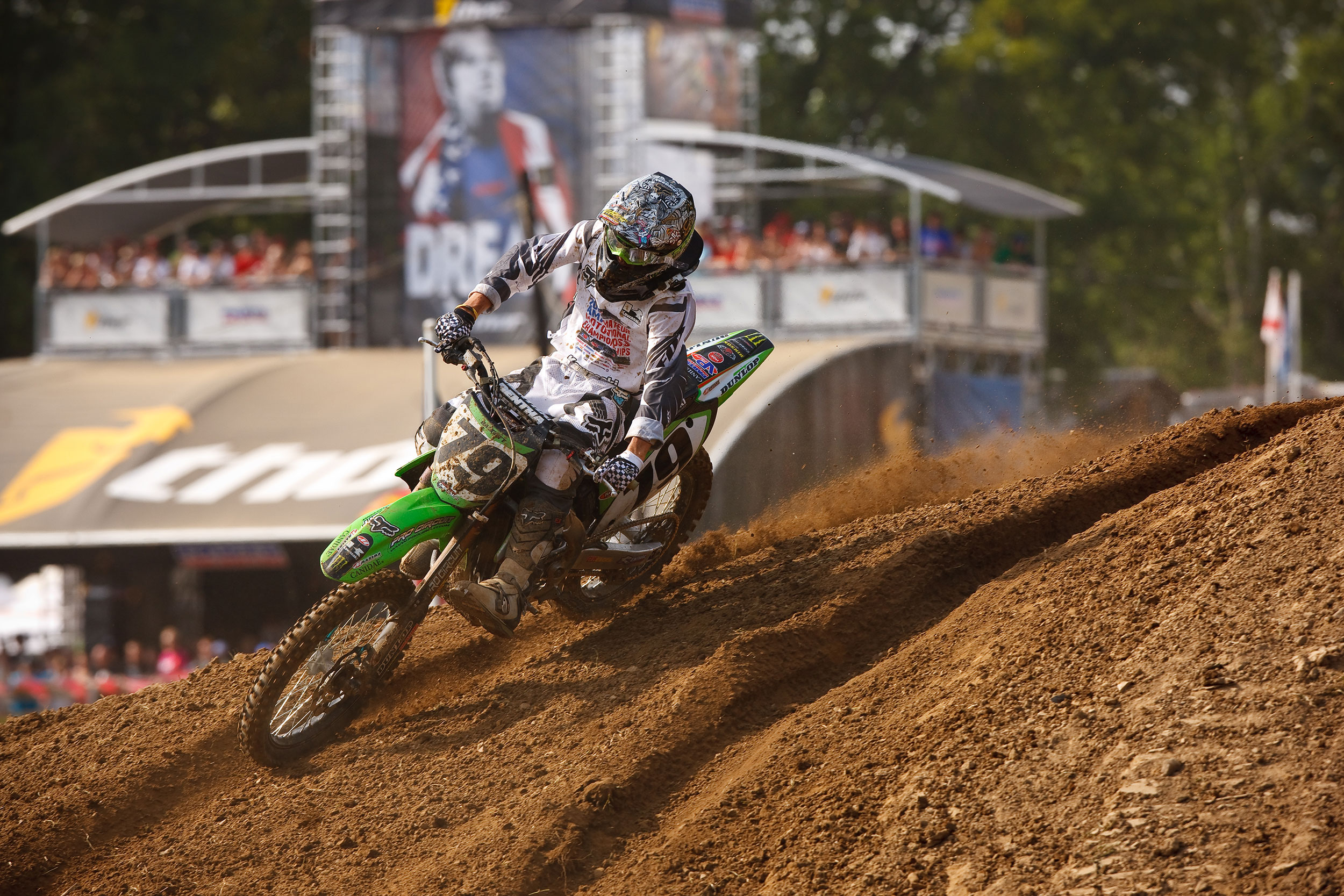
Blake Baggett
How The Deal Was Done
The Lynn’s dude ranch had hosted a BMW Motorcycle Owners Association rally and a road rally organized by AMA Motorcycle Hall of Famer Craig Vetter before Schlegel approached Loretta Lynn’s husband, Mooney Lynn, about hosting the AMA Amateur National Motocross Championship.
Schlegel first called Lynn to discuss his idea and later visited the ranch to pitch the deal. While Schlegel was at a meeting with the Lynns, Coombs was attending the Ponca City motocross event. Schlegel telephoned Coombs to tell him about the ranch, and Coombs stopped at the Lynn’s ranch on the way home.
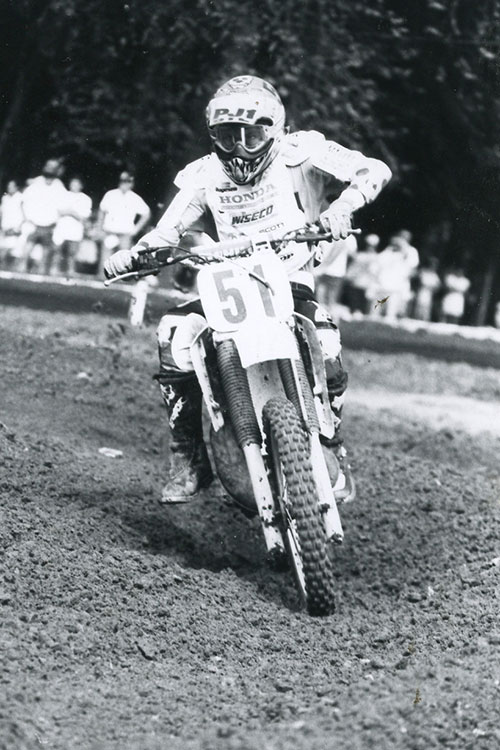
Damon Bradshaw
“[My dad’s] partner in the project, Paul Schlegel, suggested we stop at Loretta Lynn’s on the way home,” Coombs said. “It was perfect, and so we then drove straight to the AMA in the old Westerville (Ohio) offices, so they could pitch the idea.”
Coombs said his dad was impressed with the facilities at the Lynns’ ranch.
“My dad knew that, for a lot of families, this race would be their summer vacation, so he wanted a place [where there were] other things to do than a traditional race track,” he said. “Loretta Lynn’s Ranch had a pool, water slide, horseback riding, canoes, mini golf and more. It was a campground for country music fans. They loved the idea of having it filled up for one week in the middle of summer by a bunch of families, and we’ve been working together ever since.”
At first, Dave Coombs had to work hard to overcome Mooney Lynn’s hesitation to host a motorcycle event.
“When dad told Mooney his idea, Mooney said that they had tried motorcycles already and not too many [came],” he said. “Dad explained that these were dirt bikes, not road bikes, and they were families, not single riders or couples [who] would be here all week.
“Mooney pretty much said, ‘OK, let’s give it a shot.’ They did a five-year deal on the spot, and then the AMA gave my dad a five-year deal.”
Loretta and Mooney Lynn’s grandson, Anthony Brutto, said Mooney Lynn was a little apprehensive at first, but the relationship with Dave Coombs eased the situation greatly.
“My grandfather was hesitant about it,” Brutto said. “We always had a great working relationship with the Coombs family. Our family has a lot of love for the Coombs family and the event.”
Schlegel wanted to hold the races in a ravine behind the ranch’s general store. Coombs quickly shot down that idea.
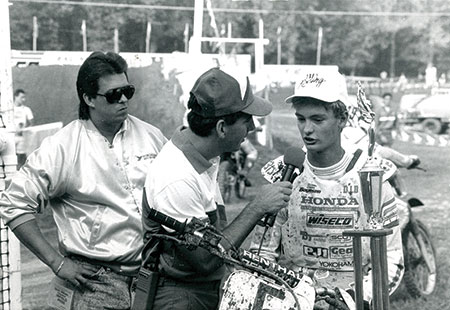
Jimmy Button
Coombs found a pasture elsewhere on the ranch for the track.
“The joke was that we were holding a national motocross event on the only flat piece of land in Tennessee,” Schlegel said.
To promote the event, Coombs and Schlegel then formed the company that would later become MX Sports.
Coombs took the lead on designing the track and garnering interest within the amateur racing community.
“Dave was a great track designer,” Schlegel said. “He also had great relationships with amateur riders from his experience promoting a cross-country race in West Virginia. I always had the best relationship with the Coombs.”
Schlegel took the lead on setting up and overseeing the area- and regional-qualifier system that would determine which amateur riders would have the privilege of riding the Loretta Lynn’s national.
Schlegel also was responsible for renting campsites and coordinating the gate at the new event.
“We sold campsites, but didn’t charge an admission,” Schlegel said. “We just charged a fee for each car that came in.”
The Early Years
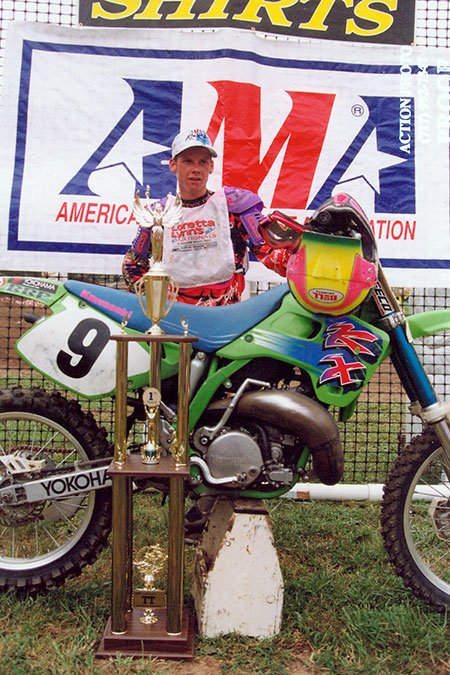
Tim Ferry
When marketing the first Loretta Lynn’s national, the elder Coombs “did two very smart things,” Davey Coombs said.
“First, he called Dave Jordan, manager of Kawasaki’s new amateur support program Team Green,” Coombs said. “He told him he would make him a sponsor of the race if he simply put it in his riders’ contracts that they needed to attend the AMA Amateur National Motocross Championships at Loretta Lynn’s.”
Jordan agreed, and Team Green has been there ever since, whether Kawasaki was a sponsor or not.
Dave Coombs also invited his friend, Rick “Super Hunky” Sieman, to come cover the race for his magazine, Dirt Bike. Rick came, wrote about it, and started the momentum early for the following year.
For Schlegel, the first Loretta Lynn’s proved an instant success.
“It looked like a world championship from Day One,” Schlegel said. “The factories were there from the start.”
Schlegel remained involved in the Loretta Lynn’s national until 1988.
“When I turned 50, I decided it was time to get out,” he said. “I gave my share of the Loretta Lynn’s event to Dave and Mary McCarthy. Dave had worked for me for a long time. Dave and Mary later sold their share of the event to Dave Coombs’ wife, Rita.”
John Grewe was one of the riders who competed at the first Loretta Lynn’s.

James Stewart
“I was 16 years old when I came to Loretta’s for the first time,” he said. “I had been racing for three years. That year the Ponca City event was the week before Loretta’s, so my family went straight from Ponca City to Hurricane Mills.”
Grewe also recalled experiencing one of the event’s most challenging features right from the start.
“My first impression of the place was the heat,” he said. “The heat and humidity in Tennessee in early August are brutal. That made it very different from other motocross events.”
Grewe qualified this year for his 22nd Loretta’s, and he says he has never finished outside the top five in his class.
When Sacred Set In
Coombs credits his father’s concept of the event for making the AMA Amateur National Motocross Championship at Loretta Lynn’s so special to so many.
“He designed a race where, once you qualified at the regional, you were in at Loretta Lynn’s—no qualifiers or heat races when you got there,” he said. “It took the pressure off the kids, off the parents, and let them have a little fun and relax and enjoy the fraternity of it all.”
Brutto recalled how the Loretta Lynn’s national has affected his life and family.
“My mom and dad met at the event,” he said. “I made so many friends from the event. I’ll always remember the time my family spent with the Coombs.”
Brutto shared his fondest memories.
“I grew up coming to the races,” he said. “I was always excited for them. I’ll always remember the pre-event and post-event work. I was a 6-year-old with a golf cart during the event. I’d drive around and throw water balloons at people.”

Damon Huffman
For Brutto, part of the event’s sacredness comes from watching the stars of motocross and supercross visit.
“It has been amazing seeing all the big names that have come through the event, and then come back to visit,” he said. “I remember when [GNCC star and ISDE gold medalist] Kailub Russell came through. He and I would ride our bikes together. I also remember other big names coming through, like Ricky Carmichael and James Stewart.”
Brutto said he had a tough time sensing how special the event is to the general public, because he grew up around it.
His grandmother Loretta talked about having a similar experience in understanding the event’s magnitude.
“She’s always enjoyed opening the ranch up to guests,” he said. “The ranch and all of its events have always ranked high with her. I’m not sure anyone in the 1980s could have anticipated the event growing to what it is today.”
For Grewe, the event was immediately special.
“It felt different right from the start,” he said. “Part of it was the setting. It wasn’t just another motocross track, because it was built just for the national.”
Grewe also said the challenge, and the heightened status of the event, is as much a result of the difficulty of getting there as it is from competing once you arrive.
The Present, Future Of Loretta Lynn’s
For Schlegel, the event has a bright future and is continuing to grow.
“The number of competitors at Loretta Lynn’s hasn’t really changed,” he said. “The base has grown, though. In 1982, we had about 4,500 people there. Now, it’s up to about 18,000.
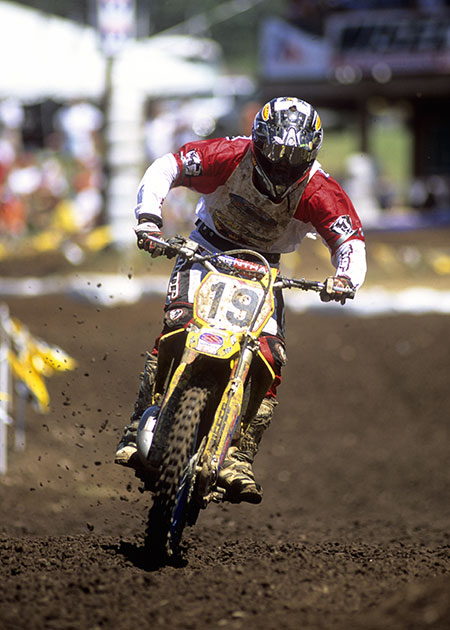
Evan Laughridge
“Loretta Lynn’s is the greatest motorcycle event in the world,” he continued. “I am convinced that, when every other race has been run for the last time, Loretta Lynn’s will still be going strong.”
Coombs has a similar outlook on the future of the event.
“I think Loretta Lynn’s will be there as long as motocross is a thing,” he said. “I don’t know that I would change much of anything. It’s in a constant state of evolution and it changes with the times, with the sport, [and] with the people. I just wish we had better wi-fi and cell service!”
Brutto has adopted his grandmother’s drive to continue entertaining the amateur motocross community at the ranch. He also is looking at ways to make the event even better for younger riders
For Rickords, the goal with Loretta’s is to keep its traditions alive.
“Our goal at the AMA is to maintain the Rocky Mountain ATV/MC AMA National Amateur Motocross Championship at Loretta Lynn’s for years to come,” he said. “The site has a lot of history behind it, and we are looking forward to continuing to adding to that history year after year.
“It is motivating to see the passion that the Coombs family puts into the event,” he continued. “They’re involvement is a very important part of it.”

